|
|
|
Sort Order |
|
|
|
Items / Page
|
|
|
|
|
|
|
| Srl | Item |
| 1 |
ID:
132344
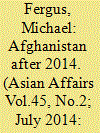

|
|
|
|
|
| Publication |
2014.
|
| Summary/Abstract |
A number of the NGOs now working in Afghanistan, like Oxfam, Afghan Aid and the Agha Khan Foundation have been there for many years and show no sign of planning to leave when NATO troops withdraw. This article is written by a committee member of the Norwegian Afghanistan Committee, which was formally established in Bergen in 1980, as a political reaction to the Soviet invasion. In 1983, the Committee started sending health workers into unoccupied areas of the country and their activities have continued ever since, though the Soviets left nearly a quarter of a century ago. The goodwill and contacts built up over time by the Committee and other NGOs have been important in validating their presence, their activities and their motives. To be useful in Afghanistan needs a commitment to the long haul.
|
|
|
|
|
|
|
|
|
|
|
|
|
|
|
|
| 2 |
ID:
132326
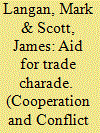

|
|
|
|
|
| Publication |
2014.
|
| Summary/Abstract |
Aid for Trade (AfT) has gained prominence as an innovative form of donor support in the 'post'-Washington Consensus. AfT mechanisms have been praised as a means of aligning trade liberalisation deals (whether in the Doha Round or within bilaterals) to poverty reduction objectives. This article, through critical analysis of AfT discourse within the 'moral economies' of multilateral World Trade Organization and bilateral European Union-African, Caribbean and Pacific negotiations, points to the strategic purposes of donor language in rationalising asymmetric North-South trade systems. Moreover, it questions the 'development' credentials of AfT assistance by examining some of the ensuing private sector activities and the impact on the supposed beneficiaries, and the tying of AfT disbursements to the implementation of inappropriate policies.
|
|
|
|
|
|
|
|
|
|
|
|
|
|
|
|
| 3 |
ID:
127344
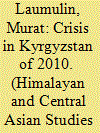

|
|
|
| 4 |
ID:
116513
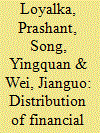

|
|
|
|
|
| Publication |
2012.
|
| Summary/Abstract |
China's central government incrementally introduced various kinds of student financial aid since the late 1990s in response to public concerns about the rising burden of college prices. Despite the marked increase in financial assistance from governmental as well as non-governmental sources in recent years especially, little is known about how well aid is currently distributed across Chinese universities and whether it is successfully reaching needy students.
We use a unique randomly-sampled dataset of all local senior college students in one northwest province and a combination of non-parametric, semi-parametric and fixed effects methods to examine how various types of financial aid are currently distributed to students of different backgrounds across the university system. We also evaluate whether aid is reaching the main target population of low-income students. We primarily find that government-financed aid is allocated evenly across universities of varying selectivity and is reaching its target population of low-income students within universities. By contrast, university- and society-financed aid is not reaching low-income students. In addition, students in the most selective universities receive large implicit subsidies as they have high instructional costs, get more aid, and pay low tuition fees. Finally, a significant proportion of disadvantaged students do not seem to receive any type of aid.
|
|
|
|
|
|
|
|
|
|
|
|
|
|
|
|
| 5 |
ID:
120621
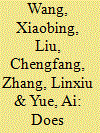

|
|
|
|
|
| Publication |
2013.
|
| Summary/Abstract |
The rapid expansion of enrollment capacity in China's colleges since the late 1990s has come at the price of high tuition hikes. China's government has put forth financial aid programs to enable poor students to access higher education. Although studies have shown that poor high school students are indeed able to attend college when their test scores are high enough (that is, few are unable to attend when they are qualified to attend), the literature has not explored whether poor students have sufficient amounts of aid to thrive in college.
Using findings from a randomized controlled trial, this study evaluates the impact of providing full scholarships to students from poor rural areas (henceforth treatment students) on student stress levels, self-esteem/self-efficacy, and participation in activities in four first-tier colleges. To do so, we compare outcomes of the treatment students with students who were not given full scholarships by the project (and were left to search for scholarships and other sources of financial aid from the university system itself-the control students). The project was run among the 200 poorest first-year students in four first-tier colleges in inland China. Somewhat surprisingly, we find that treatment students (those receiving full scholarships from the project) were only slightly more successful in obtaining financial aid than control students. This suggests that control students (those who did not receive full scholarships from the project) were still able to access comparable levels of financial aid. Most importantly, scholarship recipients were statistically identical in outcome to control students in terms of stress, self-esteem, and participation in college activities, suggesting that poor students (who are dependent on aid from the university system) currently are able to access sufficient levels of financial aid, are able to take advantage of the activities offered at college, and do not shoulder heavy financial or psychological costs.
We find, therefore, that efforts of the government to alleviate the financial burden of college on the poor have been relatively successful in first-tier colleges. Because of this, foundations and individuals may decide that if they want to improve human welfare, giving additional scholarships at high tier colleges may be having little effect.
|
|
|
|
|
|
|
|
|
|
|
|
|
|
|
|
| 6 |
ID:
131373


|
|
|
|
|
| Publication |
2014.
|
| Summary/Abstract |
The complex relationship between democracy and development has been extensively discussed in academic literature. However, we do not have much knowledge of how this translates into donor practices. How does the European Commission (EC) deal with tensions arising from promoting democracy and development? To answer this question, this article operationalises the distinction between 'democracy promoters' and 'developmental donors', focusing specifically on budget support and governance incentive tranches. Empirically we examine the implementation of the EC's budget support and Governance Incentive Tranche in Ethiopia (2005-10), a case where the dilemma between democracy promotion and development cooperation is particularly strong. Investigating the position of the EC along the democracy promoter versus developmental donor continuum, we conclude that the EC's position lies between these extremes. However, in the case of budget support, a shift has been made away from the Commission being a democracy promoter and towards the role of developmental donor.
|
|
|
|
|
|
|
|
|
|
|
|
|
|
|
|
| 7 |
ID:
128982
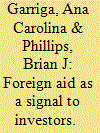

|
|
|
|
|
| Publication |
2014.
|
| Summary/Abstract |
Does development aid attract foreign direct investment (FDI) in post-conflict countries? This article contributes to the growing literature on effects of aid and on determinants of FDI by explaining how development aid in low-information environments is a signal that can attract investment. Before investing abroad, firms seek data on potential host countries. In post-conflict countries, reliable information is poor, in part because governments face unusual incentives to misrepresent information. In these conditions, firms look to signals. One is development aid, because donors tend to give more to countries they trust to properly handle the funds. Our results show that aid seems to draw FDI-however, this is conditional on whether the aid can be considered geostrategically motivated. We also show that this effect decreases as time elapses after the conflict. This suggests that aid's signaling effect is specific to low-information environments, and helps rule out alternative causal mechanisms linking aid and FDI.
aid
|
|
|
|
|
|
|
|
|
|
|
|
|
|
|
|
| 8 |
ID:
129203


|
|
|
|
|
| Publication |
2014.
|
| Summary/Abstract |
The Global Fund to Fight AIDS, Tuberculosis, and Malaria is one of the world's largest funders of global health programs. From 2002 to 2011, the Global Fund disbursed about US$15.5 billion to support programs aiming to prevent and treat the three diseases, to care for the people suffering from them, and to strengthen health systems in more than 150 low- and middle-income countries. At its replenishment meeting this December, the Global Fund pledged $12 billion to supporting programs through 2016. Yet, while the Global Fund has made important contributions to the fight against AIDS, tuberculosis, and malaria over the past decade, each year over 3 million people still die from these three diseases. Millions more suffer from extended periods of sickness. Only about half of people eligible for anti-retroviral (ARV) medicines in developing countries actually enroll in treatment. It is therefore worth remembering that the same moral imperative that drove the creation of the Global Fund over a decade ago also compels the Fund and its partners to do whatever they can to ensure that the billions of dollars the Fund raises and disburses reduce the disease burden as efficiently as possible
|
|
|
|
|
|
|
|
|
|
|
|
|
|
|
|
| 9 |
ID:
120606
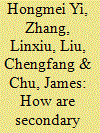

|
|
|
|
|
| Publication |
2013.
|
| Summary/Abstract |
Drawing on a survey of 106 secondary vocational schools and 7309 students in two provinces of China, this descriptive paper assesses whether vocational schooling is measuring up to government benchmarks for quality and whether poor students are able to access quality schools. We find that secondary vocational schools have met government benchmarks for teacher qualification and training, student opportunities for practical training and adequate facilities. Furthermore, poor students access schools of similar quality to non-poor students, even though 34 percent of poor students do not receive financial aid. We conclude that recent policies are successfully ensuring secondary vocational school quality and equity of access to school quality between poor and non-poor students. However, financial aid policies should be re-examined, such that poor students receive sufficient coverage. Moreover, given that input-based measures only proxy school quality, the government should consider holding schools accountable for outcomes such as student learning.
|
|
|
|
|
|
|
|
|
|
|
|
|
|
|
|
| 10 |
ID:
131193
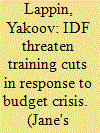

|
|
|
|
|
| Publication |
2014.
|
| Summary/Abstract |
Israel defence force (IDF) are preparing to reduce their training activities amid a growing budget crisis
|
|
|
|
|
|
|
|
|
|
|
|
|
|
|
|
| 11 |
ID:
128390
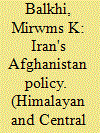

|
|
|
|
|
| Publication |
2011.
|
| Summary/Abstract |
The financial assistance of Iranian authorities to the President of Afghanistan Hamid Karzai in October 2010, has once again sparked the discussion on Iranian policy towards Afghanistan. The fable of "money envelopes" which was delivered by Islamic Republic of Iran by non- diplomatic means remains a hot topic both inside and outside Afghanistan. llamid Karzai confirmed at a press conference that his chief of office receives cash between five to seven hundred thousand Euros: twice each year from Iran. Though the President of Afghanistan clari?ed that this controversial so called financial aid has been part of the' international financial support in which Iran is involved in the post- Taliban reconstruction of Afghanistan, his reply could not convince the- analysts who are experts on Iran and Afghanistan policies. The main reason that the issue became controversial has been theonedia propaganda related to this issue in which Iran is accused of providing military aid and financial support to the Taliban in Afghanistan. The seizure of two thousand oil tankers by Iranian government which resul - _ in a large anti-Iranian demonstration in Kabul against the Iran emba _ highlighted the issue. Few months before, in March 2010, Irani President Mahmud Ahmadinezhad during his visit to Kabul emphas' - y. Iran's disagreement over the presence of NATO in Afghanistan. He sai to regional peace."
|
|
|
|
|
|
|
|
|
|
|
|
|
|
|
|
| 12 |
ID:
131662
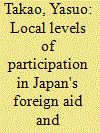

|
|
|
|
|
| Publication |
2014.
|
| Summary/Abstract |
This study will examine the determinants of local Japanese government involvement in decentralized international cooperation by taking an actor-specific approach to three outstanding cases: Shiga Prefecture, Kitakyushu City, and Yokohama City. It will look beneath the aggregate relationships to more qualitative evidence of localized motives for Japanese cooperation with developing countries.
|
|
|
|
|
|
|
|
|
|
|
|
|
|
|
|
| 13 |
ID:
161882
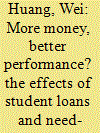

|
|
|
|
|
| Summary/Abstract |
The goal of this study is to examine the effect of student loans and need-based grants on financially disadvantaged student academic performance in China's higher education. We used a large sampled data from 101 universities to conduct our study. By employing different matching methods, we found that receiving a student loan did not improve student academic performance, but slightly increased students' likelihood of doing a part-time job. Likewise, receiving a need-based grant had no significant effect on student academic performance. We argue that current financial aid programs do not yield any measurable improvement on student performance. Reform and more rigorous evaluations are needed to design an effective financial aid program to promote the development of higher education in China.
|
|
|
|
|
|
|
|
|
|
|
|
|
|
|
|
| 14 |
ID:
124895
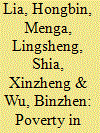

|
|
|
|
|
| Publication |
2013.
|
| Summary/Abstract |
We use the Chinese College Student Survey, conducted in 2010, to examine levels of poverty among students on China's campuses. With the poverty line defined as the college-specific expenditures a student needs to maintain a basic living standard on campus, we find that 22 per cent of college students in China are living in poverty. Poverty is more severe among students from rural or western parts of the country. With a targeting count error of more than 50 per cent, it is important that the college need-based aid programme be improved. Lacking other income sources, poor students rely heavily on loans and paid employment to finance their college education.
|
|
|
|
|
|
|
|
|
|
|
|
|
|
|
|
| 15 |
ID:
130473
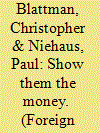

|
|
|
|
|
| Publication |
2014.
|
| Summary/Abstract |
Every year, wealthy countries spend billions of dollars to help the world's poor, paying for cows, goats, seeds, beans, textbooks, business training, microloans, and much more. Such aid is designed to give poor people things they can't afford or the tools and skills to earn more. Much of this aid undoubtedly works. But even when assistance programs accomplish things, they often do so in a tremendously expensive and inefficient way. Part of this is due to overhead, but overhead costs get far more attention than they deserve. More worrisome is the actual price of procuring and giving away goats, textbooks, sacks of beans, and the like.
Most development agencies either fail to track their costs precisely or keep their accounting books confidential, but a number of candid organizations have opened themselves up to scrutiny. Their experiences suggest that delivering stuff to the poor is a lot more expensive than one might expect.
Take cows. Many Western organizations give poor families livestock, along with training in how to raise and profit from the animals. Cows themselves usually cost no more than a few hundred dollars each, but delivering them -- targeting recipients, administering the donations, transporting the animals -- gets expensive. In West Bengal, India, for example, the nonprofit Bandhan spends $331 to get $166 worth of local livestock and other assets to the poor, according to a report by the rating agency Micro-Credit Ratings International. Yet even this program sounds like a bargain compared to others. In Rwanda, a study led by the economist Rosemary Rawlins found that the cost of donating a pregnant cow, with attendant training classes and support services, through the charity Heifer International can reach $3,000.
|
|
|
|
|
|
|
|
|
|
|
|
|
|
|
|
| 16 |
ID:
132127
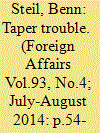

|
|
|
|
|
| Publication |
2014.
|
| Summary/Abstract |
In April 2013, Ukraine was sporting a massive current account deficit of eight percent, and it badly needed dollars to pay for vital imports. Yet on April 10, President Viktor Yanukovych's government rejected terms set by the International Monetary Fund (IMF) for a $15 billion financial assistance package, choosing instead to continue financing the gap between its domestic production and its much higher consumption by borrowing dollars privately from abroad. So a week later, Kiev issued a ten-year, $1.25 billion eurobond, which cash-flush foreign investors gobbled up at a 7.5 percent yield.
|
|
|
|
|
|
|
|
|
|
|
|
|
|
|
|
| 17 |
ID:
104420


|
|
|
| 18 |
ID:
134201
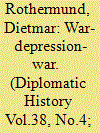

|
|
|
|
|
| Publication |
2014.
|
| Summary/Abstract |
War was over, the nations that had participated in it were burdened by enormous war debts. They had financed their war expenditure to a large extent on credit. War bonds had been taken up by the people and, in addition, foreign loans, mostly from the United States, had also been raised.
|
|
|
|
|
|
|
|
|
|
|
|
|
|
|
|
|
|
|
|
|